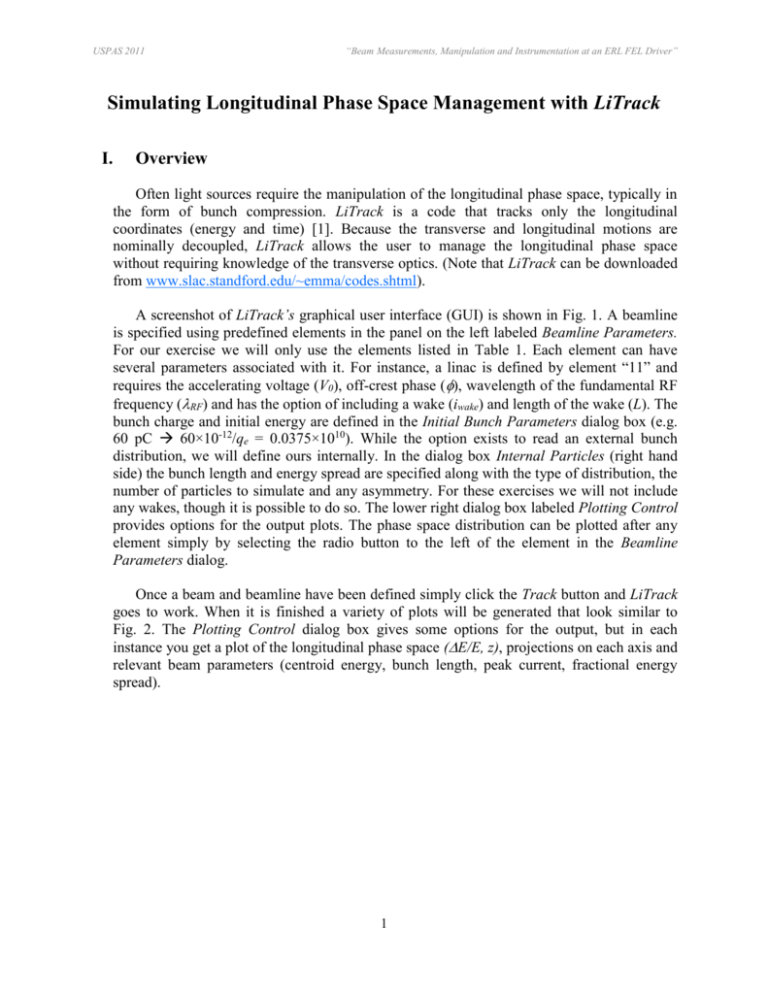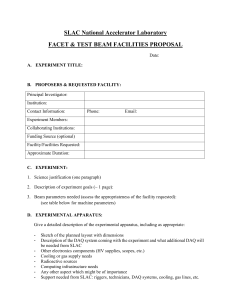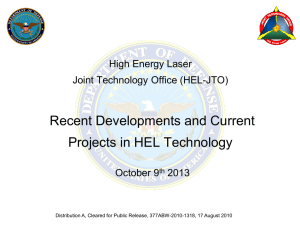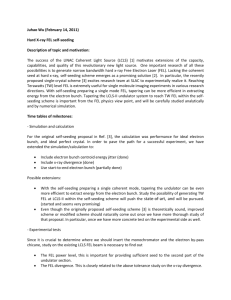LiTrack Exercise
advertisement

USPAS 2011 “Beam Measurements, Manipulation and Instrumentation at an ERL FEL Driver” Simulating Longitudinal Phase Space Management with LiTrack I. Overview Often light sources require the manipulation of the longitudinal phase space, typically in the form of bunch compression. LiTrack is a code that tracks only the longitudinal coordinates (energy and time) [1]. Because the transverse and longitudinal motions are nominally decoupled, LiTrack allows the user to manage the longitudinal phase space without requiring knowledge of the transverse optics. (Note that LiTrack can be downloaded from www.slac.standford.edu/~emma/codes.shtml). A screenshot of LiTrack’s graphical user interface (GUI) is shown in Fig. 1. A beamline is specified using predefined elements in the panel on the left labeled Beamline Parameters. For our exercise we will only use the elements listed in Table 1. Each element can have several parameters associated with it. For instance, a linac is defined by element “11” and requires the accelerating voltage (V0), off-crest phase (), wavelength of the fundamental RF frequency (RF) and has the option of including a wake (iwake) and length of the wake (L). The bunch charge and initial energy are defined in the Initial Bunch Parameters dialog box (e.g. 60 pC 60×10-12/qe = 0.0375×1010). While the option exists to read an external bunch distribution, we will define ours internally. In the dialog box Internal Particles (right hand side) the bunch length and energy spread are specified along with the type of distribution, the number of particles to simulate and any asymmetry. For these exercises we will not include any wakes, though it is possible to do so. The lower right dialog box labeled Plotting Control provides options for the output plots. The phase space distribution can be plotted after any element simply by selecting the radio button to the left of the element in the Beamline Parameters dialog. Once a beam and beamline have been defined simply click the Track button and LiTrack goes to work. When it is finished a variety of plots will be generated that look similar to Fig. 2. The Plotting Control dialog box gives some options for the output, but in each instance you get a plot of the longitudinal phase space (E/E, z), projections on each axis and relevant beam parameters (centroid energy, bunch length, peak current, fractional energy spread). 1 USPAS 2011 “Beam Measurements, Manipulation and Instrumentation at an ERL FEL Driver” Fig. 1: Screenshot of the LiTrack GUI. Table 1: Common elements used in LiTrack for constructing a beamline. Description Mark Compressor Linac Energy Spread Stop Code 1 6 11 22 99 P1 P2 R56 V0 T566 P3 P4 P5 E0 U5666 iwake L RF Fig. 2: Screenshot of the LiTrack output plot. 2 USPAS 2011 II. “Beam Measurements, Manipulation and Instrumentation at an ERL FEL Driver” Case Study: JLab UV FEL Driver With the LiTrack GUI open, double-click the file “JLAB_UV_FEL.mat” from the Select/Restore Files dialog box. The file describes the longitudinal dynamics in the Jefferson Laboratory UV FEL Driver. A 60 pC bunch is injected into the linac at 8.95 MeV. The linac is modeled as 3 separate cryomodules and the beam reaches a maximum energy of 135.44 MeV. The entire linac-to-wiggler transport is described in the first compressor element (“6”), the FEL is modeled with the energy spread element (“22”) and the wiggler-tolinac is described in the second compressor (“6”) before returning through the linac for energy recovery. Figure 3 illustrates the designed longitudinal match for the machine (even though the IR FEL line is shown, the concept is the same for the UV FEL line). Figure 3: Schematic showing the longitudinal match in the Jefferson Laboratory IR FEL. The green colored phase spaces represent the first pass, or accelerating, beam while red denotes the second pass, or energy recovered, beam. Note the FEL induced energy spread at the exit of the wiggler. 1) Laser OFF a) Click on the Track button and examine the resulting phase space plots. In order to lase strongly the FEL requires a high peak current (short bunch) at the entrance of the wiggler. The current setup indicates a poor longitudinal match. Using trial and error we will set the first- and second-order momentum compactions (i.e. R56 and T566) for the recirculator. i) Minimize the bunch length at the wiggler by adjusting the R56 (to the nearest 0.01 m) and T566 (to the nearest 0.1 m) of the linac-to-wiggler transport. Record the resulting momentum compactions, bunch length and energy spread at wiggler. R56 = ______ m T566 = ______ m z = ______ m = _______ ps = ______ % 3 USPAS 2011 “Beam Measurements, Manipulation and Instrumentation at an ERL FEL Driver” ii) With the longitudinal match to the wiggler established, we will now set the compactions for energy recovery. The goal is to take the short bunch at the wiggler and with a choice of proper compactions in the wiggler-to-linac transport, transform it back into the aspect ratio that we had an injection into the linac (refer to Fig. 3). b) Change the off-crest acceleration phases in the 3 cryomodules from 10° to +10° and repeat Steps i) and ii). i) What changes, if any, are there? c) Change off-crest acceleration phase to 20° and the energy (the third column in both of the “6” elements) to 0.12995 GeV. i) Repeat Step i). What are the momentum compactions? R56 = ______ m T566 = ______ m How have beam parameters at the wiggler changed? z = ______ m = ______ % d) Return the acceleration phase to 10°, the energy to 0.13544 GeV and the momentum compactions to those used in Step i) to minimize the bunch length. 2) Laser ON a) As a result of the FEL lasing the energy spread increases. To simulate the effect of lasing we use the “22” element in LiTrack to add a random energy spread to the distribution. (Strictly speaking, in addition to an increase in energy spread, the centroid energy of the bunch decreases as power is extracted from the FEL. For the time being we will neglect this effect). Set the first column of the “22” element to 0.015. i) Click Track. Do you notice any change in the bunch distributions downstream of the wiggler? Where? Hint: what is the fractional energy spread at the dump) = ______ % ii) Given the fractional energy spread, what is the absolute energy spread at the dump? The dump energy acceptance is 500 keV (full). Is this an issue? = ______ keV b) Move the bunch further away from the RF trough by changing the deceleration phase from 170° to 160° in the second set of linac definitions. By changing the phase we have 4 USPAS 2011 “Beam Measurements, Manipulation and Instrumentation at an ERL FEL Driver” altered the longitudinal match. Optimize the energy recovery match by minimizing the fractional energy spread at the dump using R56, T566 and U5666 in the wiggler-to-linac transport. Hint: while you can do this by trial and error, from what you learned in the previous section, you should be able to get in the ballpark fairly quickly. What are the new compaction values? What is the bunch length and fractional energy spread at the dump? R56 = ______ m T566 = ______ m U5666 = ______ m z = ______ m = ______ % c) What are the implications when operating with “incomplete energy recovery” (i.e. when the accelerated and decelerated beams are not 180° apart)? d) Turn the laser off by setting the “22” element back to zero. What changes at the dump? III. Deriving Momentum Compactions In this section we will derive analytic expressions for the required first- and second-order momentum compactions to transform a long injected bunch with small energy spread to a short, upright bunch at the wiggler [2]. Consider a bunch length, 𝑙 inj and energy, Einj generated from the injector. The effect of accelerating the bunch off-crest results in a bunch length, energy spread and centroid energy at the end of the linac (denoted by the subscript 𝑙) of ℓ𝑙 = ℓ𝑖𝑛𝑗 Δ𝐸𝑙 = Δ𝐸𝑖𝑛𝑗 + Δ𝐸𝑅𝐹 𝐸ℓ (𝑧 = 0) = 𝐸𝑖𝑛𝑗 + 𝐸𝑙𝑖𝑛𝑎𝑐 cos 𝜙𝑜 ≝ 𝐸𝑚𝑎𝑥 where Δ𝐸𝑅𝐹 = 𝐸𝑙𝑖𝑛𝑎𝑐 [cos(𝜙𝑜 − 𝑘𝑅𝐹 ℓ𝑖𝑛𝑗 ) − cos 𝜙𝑜 ], 𝑘𝑅𝐹 = 2𝜋/𝜆𝑅𝐹 , and o is the off-crest acceleration phase. Assume that the energy spread from the injector is negligible, Δ𝐸𝑖𝑛𝑗 = 0. The bunch length, energy spread and centroid energy after the linac-to-wiggler transport can be written in terms of parameters at the end of the linac as Δ𝐸 Δ𝐸 2 ℓ𝑎 = ℓ𝑙 + 𝑀56 ( ) + 𝑇566 ( ) 𝐸 𝑙 𝐸 𝑙 Δ𝐸𝑙 = Δ𝐸𝑙 𝐸𝑎 (𝑧 = 0) = 𝐸𝑙 (𝑧 = 0) By combining the above two sets of equations, we find the following equations for the bunch length, energy spread and centroid energy at the wiggler in terms of the injected beam parameters 5 USPAS 2011 “Beam Measurements, Manipulation and Instrumentation at an ERL FEL Driver” Δ𝐸𝑅𝐹 ℓ𝑤 = ℓ𝑖𝑛𝑗 + 𝑀56 (𝐸 𝑚𝑎𝑥 Δ𝐸𝑅𝐹 2 ) + 𝑇566 (𝐸 𝑚𝑎𝑥 ) (1) Δ𝐸𝑤 = Δ𝐸𝑅𝐹 𝐸𝑤 (𝑧 = 0) = 𝐸𝑚𝑎𝑥 Recall that the goal is to take the long bunch with low momentum spread and with an appropriate choice of optics, rotate the phase space to produce a short bunch at the wiggler. a) Using the equations above, derive expressions of the first- and second-order momentum compactions to minimize the bunch length at the wiggler. Hint: expand ERF to second order in ℓ𝑖𝑛𝑗 and plug into Eq. (1), then collect like powers of ℓ𝑖𝑛𝑗 and solve for R56 and T566 under the constraint that each order vanishes. Partial Answer: 𝑅56 = − 𝜆𝑅𝐹 2𝜋 𝐸 1 (𝐸 𝑚𝑎𝑥 ) 𝑠𝑖𝑛 𝜙 𝑙𝑖𝑛𝑎𝑐 𝑜 b) Express T566 in terms of R56. T566 = c) How do the calculated momentum compactions compare with the values you found through trial and error in Step i) in the previous lab exercise? Assume a maximum energy of 135 MeV, injected energy of 10 MeV, acceleration at 10° with an RF fundamental frequency of 1497 MHz. IV. Designing a Longitudinal Match In this exercise you will design a longitudinal match for an ERL driven IR FEL in LiTrack. In the first exercise we neglected the effect of the bunch centroid energy decreasing during lasing. This energy shift has implications on the machine design which we will now explore in further detail. The FEL extraction efficiency, FEL, is a figure of merit that describes the power extracted from the electron beam by the FEL. Based on operational experience we find that the full fractional energy spread at the exit of the wiggler can be approximated by Δ𝐸 ) ≈ 6 × 𝜂𝐹𝐸𝐿 𝐸 𝐹𝐸𝐿 The effect of the FEL on the bunch in longitudinal phase space is depicted in Fig. 4. There is a decrease in the centroid energy as power is transferred to the FEL and an increase in the energy spread. 6 USPAS 2011 “Beam Measurements, Manipulation and Instrumentation at an ERL FEL Driver” Figure 4: Effect of the FEL on longitudinal phase space. In order to prevent the “exhaust” beam of the FEL from falling across the RF waveform during energy recovery, the deceleration phase must exceed (see schematic in Fig. 5) 𝜙𝑑𝑒𝑐 = cos −1 (1 − 1 Δ𝐸 ) 2 𝐸 Figure 5: Schematic showing decelerated beam with perfect energy recovery but falling across the RF waveform (left) and with incomplete energy recovery with the exhaust beam moved further up the RF waveform. Assume that you have a single cryomodule that can provide a maximum of 120 MeV of energy gain, you inject at 10 MeV, the bunch from the injector is 100 pC and has an aspect ratio of 2.0 ps × 35 keV. The fractional energy spread at the wiggler must be less than 0.7% (rms) and the higher the peak current (shorter the bunch) the better. The FEL extraction efficiency is expected to be 1.5% (i.e. the “22” element needs to be set to 0.015). Assume the RF fundamental frequency is 1497 MHz. a) What is the FEL induced energy spread (rms)? FEL= ______ % b) What must the deceleration phase be in order to prevent beam from spilling across the trough of the RF waveform during energy recovery? 7 USPAS 2011 “Beam Measurements, Manipulation and Instrumentation at an ERL FEL Driver” dec= ______ degrees c) What are the calculated R56 and T566 for the wiggler-to-linac transport assuming you use the deceleration phase calculated in Step b)? R56 = _______ m T566 = _______ m d) What is the change in pathlength of the beam due to lasing? (Hint: what matrix element relates pathlength and energy?) l= ______ m = ______ degrees (at 1497 MHz) e) What is the off-crest acceleration phase for your longitudinal match? acc= ______ degrees f) What are the R56 and T566 for the linac-to-wiggler transport for your longitudinal match? R56 = _______ m T566 = _______ m g) What are the beam parameters at the wiggler? Is the energy spread specification satisfied? z = ______ m = ______ % Ipeak = ______ kA h) What are the R56 and T566 for the wiggler-to-linac transport for your longitudinal match? How do they compare with the values obtained analytically? R56 = _______ m T566 = _______ m i) Take a screenshot of the LiTrack GUI showing your finished longitudinal match (Ctrl+Alt+Prnt Scrn captures a screenshot on Windows which can then be pasted into a Word or PowerPoint). j) What would you need to change in order to generate a bunch that is twice as long and has half the energy spread (i.e. 0.35%) at the wiggler? 8 USPAS 2011 “Beam Measurements, Manipulation and Instrumentation at an ERL FEL Driver” References [1] K. Bane and P. Emma, “LiTrack: A Fast Longitudinal Phase Space Tracking Code with Graphical User Interface” Proceedings of the 2005 Particle Accelerator Conference (Knoxville, TN), pp. 4266-4268 (2005). [2] D. Douglas, et al., Technical Note 00-013, Jefferson Laboratory (1995). 9






